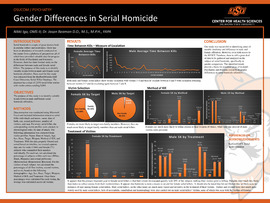| dc.contributor.author | Igo, Nikki | |
| dc.contributor.author | Beaman, Jason | |
| dc.date.accessioned | 2020-05-05T19:37:44Z | |
| dc.date.available | 2020-05-05T19:37:44Z | |
| dc.date.issued | 2020-02-28 | |
| dc.identifier | ouhd_igo_genderdifferencesinserial_2020 | |
| dc.identifier.citation | Igo, N., & Beaman, J. (2020, Feb. 28). Gender differences in serial homicide. Poster presented at Research Day at Oklahoma State University Center for Health Sciences, Tulsa, OK. | |
| dc.identifier.uri | https://hdl.handle.net/11244/324207 | |
| dc.description.abstract | Background: Serial homicide is a topic of great interest both in popular culture and academics. There has been an abundance of research conducted on the matter from a plethora of perspectives all of which have provided valuable data for progress in the fields of Psychiatry and Forensics. However, there has been limited study on the differences between male and female serial killers. The purpose of this study is to identify variable trends between male and female serial homicide offenders. Data used for this study was extracted from the Radford/Florida Gulf Coast University Serial Killer Database. The database has a total of 2,870 serial killer entries with victim entries totaling 9,064. | |
| dc.description.abstract | Methods: Data extraction was conducted using Microsoft Excel and included information related to serial killer individuals and teams, name, date of birth, sex, sexual preference, number of victims, and race. For every serial killer, the corresponding victim profiles were entered, in chronological order, by date of attack. The following information was extracted from victim profiles: Name, Date of Attack, Age, Sex, Race, Target, Weapon, Method of Kill, and Treatment. With the data properly filtered and sorted based on timeline, we created separate data sets for male (1,044) and female (71) subjects who committed their murders individually. For each set, we calculated the percentage of subjects within each race (White, Black, Hispanic) and sexual preference (Heterosexual, Homosexual, Bisexual). For the victims of each subject, we calculated the percentages of all first victims, second victims, and so on, based on the following demographics: Age, Sex, Race, Target, Weapon, Method of Kill, and Treatment. Once these percentages were calculated for each victim, the average was taken calculated across all victims. | |
| dc.description.abstract | Results: Both male and female serial killers show steady escalation with victims 1-4 and then de-escalate between 4 and 5 with escalation returning between victims 5-7 and de-escalating again between 7 and 8. Differences were identified in male and female serial killers in victim selection, weapon of choice, method of kill and treatment of victims. | |
| dc.description.abstract | Conclusion: Our study was successful in identifying areas of notable similarity and difference in male and female offenders. However, even with access to the RFGCU Database, there is still a great deal of data to be gathered and analyzed on the subject of serial homicide, specifically in gender comparison. The identified trends provide a basis for potential areas of in-depth Psychiatric and Forensic research on gender differences in serial homicide offenders. | |
| dc.format | application/pdf | |
| dc.language | en_US | |
| dc.publisher | Oklahoma State University Center for Health Services | |
| dc.rights | The author(s) retain the copyright of have the right to deposit the item giving the Oklahoma State University Library a limited, non-exclusive right to share this material in its institutional repository. Contact Digital Resources and Discovery Services at lib-dis@okstate.edu or 405-744-9161 for the permission policy on the use, reproduction or distribution of this material. | |
| dc.title | Gender differences in serial homicide | |
| osu.filename | ouhd_igo_genderdifferencesinserial_2020.pdf | |
| dc.type.genre | Presentation | |
| dc.type.material | Text | |
| dc.subject.keywords | serial homicide | |
| dc.subject.keywords | gender | |
| dc.subject.keywords | rfgcu database | |
